Non-capricious in care and ideal for pickling tomato "French bunch": an overview of the variety and the nuances of care
Novice gardeners often face a number of difficulties when growing tomatoes. After all, this culture needs regular care. To get a bountiful harvest, tomato bushes need to be regularly pinned, treated with various drugs against diseases and protected from cold snaps by planting in greenhouse structures.
Knowing about all the problems of cultivating tomatoes in our country, breeders are developing new varieties that are resistant to bad weather and tomato diseases. These include the French bunch tomato. He not only endures negative environmental factors, but also does not need to be pinned. How to grow this tomato variety and get the maximum yield - read on.
The content of the article
Description of the variety
Tomato French bunch Is a variety that, despite its name, has nothing to do with France. It was bred in Russia by Siberian breeders.
This variety is not yet in the register... It is produced by the Siberian Garden firm. The tomato has managed to gain popularity among gardeners due to its productivity and ease of care.

Distinctive features
The French bunch tomato is easy to grow... During its growth, it forms a minimum number of stepsons. Thanks to this, the bush does not need to be shaped. This is an undoubted advantage, because it is pinching that novice gardeners consider the main disadvantage of caring for tomatoes.
The fruits of this variety are oblong... They are red on the inside and outside. They contain a lot of dry matter, so most gardeners consider them not juicy enough. Berries have the usual taste for tomatoes - sweet and sour.
French bunchy ideal for canning... Fleshy tomatoes retain their shape in brine. They are also suitable for freezing in pieces. Due to the lack of juiciness, not everyone likes them fresh.
French bunch has immunity to all tomato diseases... This variety rarely affects even late blight, which often induces late blight in late-ripening tomatoes.
Main characteristics
French bunch will delight both beginners and experienced gardeners... This tomato has high yield rates with undemanding care.
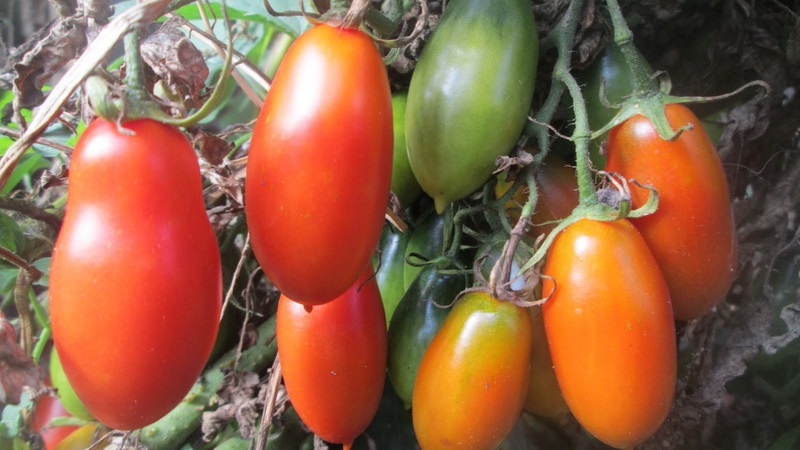
Specifications:
| Parameter | Indicators |
| Bush type | Determinant. Not a standard one. When grown in open ground, it grows up to 1 m. When grown in a greenhouse, it reaches 1.5-1.7 m. The bush is not spreading. Forms the minimum number of stepsons. The stems are thick and strong. The leaves are medium-sized, dark green, without pubescence, resembling potato leaves. The inflorescences are simple. The first is formed at the level of 7-9 sheets, following through 1 sheet. The fruits are formed by tassels. On one brush from 10 to 15 tomatoes. |
| Growing method | Suitable for growing outdoors and in greenhouses. In the northern regions, the second method is mainly used. |
| Yield | High. More than 10 kg of fruits are harvested from 1 bush per season. For 1 sq. m planted 3-4 plants. |
| Fruit | Medium size. One berry weighs from 70 to 100 g. The fruits are red-orange or bright red on the outside and red on the inside. A light spot may be present at the base and in the middle of the pulp.Inside each tomato there are 2 chambers with seeds. The shape of the tomatoes is elongated, sometimes pear-shaped. There is no pronounced ribbing at the base. The taste is sweet and sour. The fruits are fleshy, not very juicy. |
| Transportability | High. Tomatoes have a strong skin that protects them from damage during transport. The fruits of this variety are stored for more than a month. |
| Ripening terms | Medium late grade. The berries ripen 115-120 days after sowing the seeds. Fruiting continues until the first frost. |
| Disease resistance | Immunity is high. Tomato is resistant to the main diseases inherent in nightshade crops. |
Growing seedlings
Tomato seedlings begin to grow 55-65 days before planting in open ground. The timing of sowing seeds depends on the climatic characteristics of the region.:
- southern cities - end of February;
- middle zone of Russia - mid-March;
- northern regions - early April.
Seed treatment
Seed pretreatment will protect seedlings from infections, temperature changes and other negative factors. This will accelerate the germination of the planting material.
Before buying seeds you need to check their expiration dates. Expired seeds will not germinate.
To test the germination of seeds, they are soaked in a solution prepared from a teaspoon of salt and a glass of water. After half an hour, the seeds that have floated to the surface are collected and thrown away. Those specimens that have sunk to the bottom are considered suitable for planting.
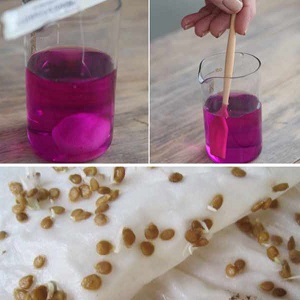 To prevent infection of seedlings black leg and other diseases, the seeds are disinfected. To do this, use several methods:
To prevent infection of seedlings black leg and other diseases, the seeds are disinfected. To do this, use several methods:
- Potassium permanganate solution... For 200 ml of water, take 2 mg of potassium permanganate. The seeds are soaked for half an hour. Then they are washed with clean water and dried.
- Hydrogen peroxide... The planting material is soaked in the product for a quarter of an hour. The seeds are washed under running water and dried.
- Soda solution... For 100 ml of water, take 0.5 tsp of salt. The seeds are soaked in the product for 10 hours. The drug not only disinfects the planting material, but also stimulates its germination.
To make the seeds germinate faster and acquired resistance to negative environmental factors, they need to be stimulated.
Methods for stimulating the germination of planting material:
- Treatment with special purchased drugs... Most often they use "Epin" or "Sodium humate".
- Using homemade remedies... Preparations such as aloe juice, honey water, soda solution are suitable.
- Cold treatment... Seeds are placed in the refrigerator for 2-3 days before planting.
Options for soil and containers for tomato seedlings
Tomato seedlings need light and nutritious soil. They buy it in a specialty store or prepare it yourself.
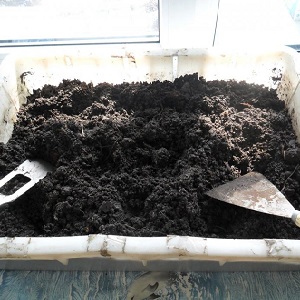 There are several options for soil mixtures for tomatoes:
There are several options for soil mixtures for tomatoes:
- Peat, humus and turf mixed in equal proportions. For 10 liters of the resulting mixture add 1 tbsp. water.
- 10 kg of peat is mixed with 1 glass of ash... The composition is added to 10 g of potassium fertilizer and urea, 30 g of superphosphate.
- Black earth and sand mixed in equal proportions. Potash fertilizers and superphosphate are used to enrich the composition.
For sowing seeds, take large containers... Plastic trays, wooden crates, cut 6 liter bottles, etc. will work. Tomatoes dive into individual pots with a volume of 300-500 ml. Plastic cups are also used. Holes are made in homemade containers.
Sowing seeds
French bunch tomato seeds are sown in the usual way... This variety tolerates picks well. In the soil, grooves are made 1 cm deep at a distance of 2 cm arcs from each other. Seeds are laid out in them, at a distance of 1.5 cm.
From above, the planting material is covered with earth... The soil is moistened with a spray bottle with warm water. The containers with seeds are covered with foil and placed in a place with a temperature of at least 23 degrees. The seeds will germinate in 3-7 days.
Other varieties of tomatoes:
Seedling care
It is not difficult to grow seedlings on your own. For this there are several important rules to follow:
- After the seeds germinate, it will not be possible to moisten the soil from the spray bottle. When watering tomato seedlings, you need to make sure that the water does not get on the greens. Use only settled liquid at room temperature.
- After the first shoots appear seedlings are recommended to be placed for a week in a well-lit place with a temperature of 15 degrees. The plants are then returned to warmth. This will prevent the tomatoes from pulling out.
- Seedlings need 16 hours of daylight... In spring, natural light will not be enough for tomatoes. This is compensated by using fluorescent lamps.
- Plants dive into individual pots after the appearance of the first two true leaves. A layer of broken brick, glass, expanded clay or shell rock is poured onto the bottom of the pots for aeration.
- 2 weeks after the pick the plants are fed for the first time. Use a growth stimulant or vermicompost. The second time fertilization is applied after another 14 days. 3 days before picking tomatoes to a permanent place, they are fed for the last time. For this, formulations with potassium and phosphorus are used.
- 10 days before picking seedlings to a permanent place they begin to temper it. Plants are taken out into the street. First for half an hour, then for 1 hour, etc. The time is gradually increased to 12-16 hours.
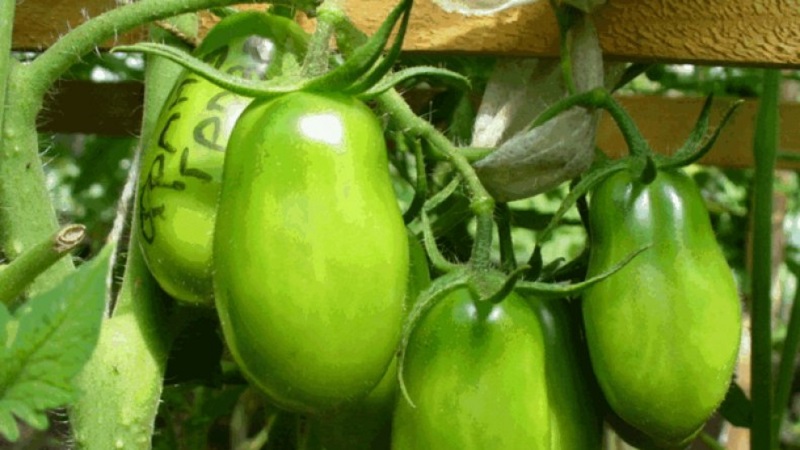
Agrotechnics
It is necessary to plant a French bunchy tomato in a permanent place when the soil warms up, and the seedlings will get stronger. The farther south the region is, the earlier the tomatoes dive to a permanent place. Usually, planting in open ground is done in May, and in a greenhouse in April.
Landing in a permanent place
Tomato beds are prepared in autumn... They are dug up and cleaned of cultivated and weed plants. To enrich the soil, humus is scattered over it. If the acidity of the soil is increased, then it is mixed with dry lime. In the spring, they again dug up the area of the garden chosen for growing tomatoes. It is fertilized with chicken droppings. Then the soil is disinfected by pouring it with a solution of copper sulfate.
Tomato holes are dug in rows in a checkerboard pattern... For 1 sq. m you need to plant no more than 4 plants. Otherwise, the yield will decrease.
On a note. 3 days before the tomatoes are planted in a permanent place, they are watered and fed. This will help them settle in their new place faster and make them easier to remove from the pot.
Plants are placed in holes along with a lump of earth.... The root is shaped towards the center. Plants are buried to the first leaves. The holes are covered with earth, compacting it.
Each tomato is watered with a liter of water... The next time the soil is moistened after 2 weeks.
Tomato care
Bushes of the French bunch tomato do not need shaping, however, experienced gardeners still recommend removing yellowed and lower leaves.
Tomatoes of this variety must be tied... Otherwise, the stems will simply break under the weight of the fruit.
Reference. A synthetic thread is used for tying, since the natural material will begin to rot.
Watering should be abundant, but not frequent... In hot summer, the soil is moistened 1 time in 2 days. Use warm, settled water. The liquid should not get on the aboveground part of the plants.
Tomatoes are fed every 2 weeks... Mineral and organic fertilizers are used. They are purchased in stores or prepared on their own.
Twice during the growing period tomatoes are applied foliar dressing using fertilizers, which include boron.
Tips for choosing top dressing
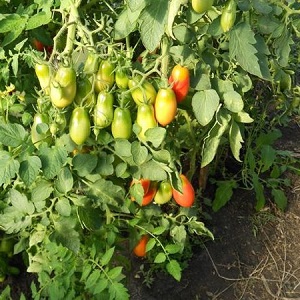 Fertilizers for tomatoes do not have to be purchased at the store. Experienced gardeners often prepare them themselves. There are several popular recipes for feeding tomatoes.:
Fertilizers for tomatoes do not have to be purchased at the store. Experienced gardeners often prepare them themselves. There are several popular recipes for feeding tomatoes.:
- Top dressing with yeast... For a 10 liter bucket of water, take 0.5 kg of chicken manure, 10 g of yeast, 5 tbsp. l. sugar and 0.5 kg of ash. The mixture is infused for a day.1 liter of the mixture is diluted in 10 liters of water. Each plant is watered with 2 liters of this fertilizer.
- Fertilizer with chicken droppings... Chicken manure is diluted with water in a ratio of 1:10. The mixture is infused for 3 days. Then add 15 g of ammonium nitrate to it. For one plant take 1 tbsp. such a composition.
- Top dressing with mullein... For 10 liters of water, take about 5 kg of mullein. Add 0.5 tsp to the resulting composition. boric acid, 1 tbsp. l. nitrophoska and 2 tablets of micronutrients. For 1 plant, take 1 liter of this composition.
Diseases and pests
The French bunch tomato has a high immunity to most tomato diseases... He does not even suffer from late blight, which is characteristic of late-ripening nightshade crops. Even good immunity to tomato diseases is not a 100% guarantee that the plant will not get sick.
It is important to follow the rules of prevention:
- All tools, containers and soil, with which the plants will interact, are disinfected. This also applies to seeds.
- Watering rules must be followed... It is important not to overmoisten or overdry the soil. The liquid should not come into contact with plant greens.
- For prevention several times per season tomatoes are sprayed with a solution of potassium permanganate, copper sulfate or Fitosporin.
- To protect plants from bugs, they are treated with soapy water and dandelion decoction. All beetles that appear on the bushes are harvested by hand.
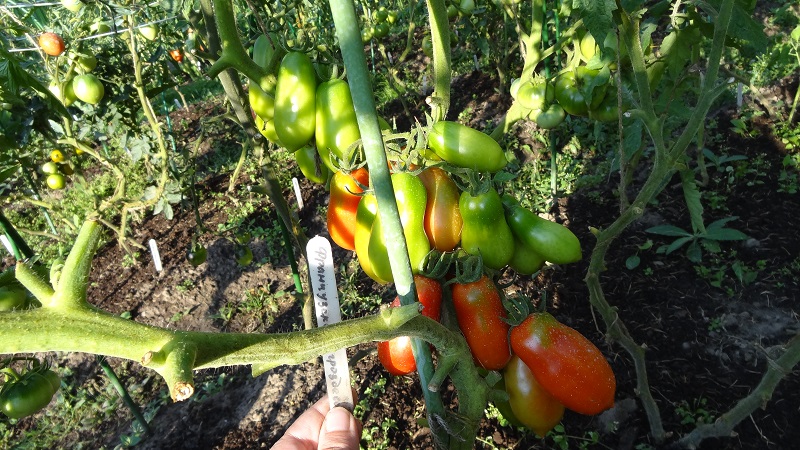
The nuances of cultivating tomatoes in open and closed ground
The greenhouse needs to maintain optimal humidity... For this, the room is regularly ventilated. This procedure helps to reduce the likelihood of plant diseases. In protected ground, the French grapefruit sometimes begins to branch strongly. If this happens, then the extra stepsons will have to be removed.
Outdoors young tomatoes face night frosts. To protect them, in the evening, the beds are covered with foil for the first 2 weeks after picking the seedlings.
Mulching the beds of tomatoes growing in unprotected soil is mandatory... The soil is covered with humus, straw or hay. These materials protect plant roots from cold, disease and pests. They are also an additional fertilizer.
Harvesting and application of the crop
The first fruits of the French bunch ripen in August... They are collected by the piece, since they do not ripen evenly on the brushes.
On cloudy days and in frost, it is recommended to pick unripe tomatoes.... They will ripen at home in a warm place.
The fruits of the French bunch can be stored for several months.... This variety is suitable for pickling and canning.
Advantages and disadvantages
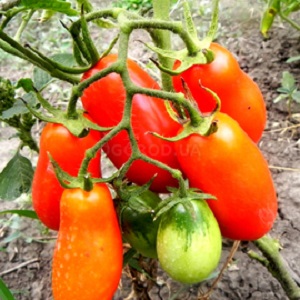 Benefits of French bunch:
Benefits of French bunch:
- the possibility of growing in protected and open ground;
- high productivity;
- high portability;
- no need for pinning;
- high immunity to tomato diseases;
- undemanding care.
Disadvantages of the variety:
- late ripeness;
- insufficient fruit juiciness.
Read also:
Features of growing a hybrid tomato "Tornado"
A variety with impeccable taste and aroma - tomato "King of London"
Farmers reviews
Reviews of the French bunch tomato are mostly positive... However, some farmers do not like the fact that the fruits of this productive variety are not juicy enough.
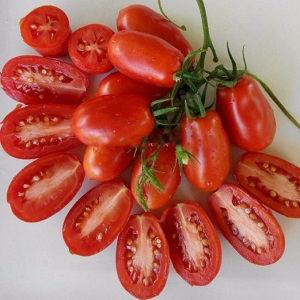 Irina Ignatieva, Moscow: “I have been planting French grapevine for the third year already. The most unpretentious variety from my collection. He does not need to be pinned, he is also not picky about watering. The fruits are really dry, but I consider it a plus, since tomatoes do not flow in salads ".
Irina Ignatieva, Moscow: “I have been planting French grapevine for the third year already. The most unpretentious variety from my collection. He does not need to be pinned, he is also not picky about watering. The fruits are really dry, but I consider it a plus, since tomatoes do not flow in salads ".
Ilya Vasiliev, Voronezh: “I didn't like the French grapevine tomato very much. Its fruits are dry and only suitable for pickling. It's really easy to grow it. From 1 sq. m collected 4 buckets of tomatoes. As in the photo, all the brushes were literally strewn with fruits ".
Conclusion
The French bunchy variety is a great option for gardeners who want to get a rich tomato crop with a minimum of effort.
This tomato does not need pinching and is able to withstand adverse environmental factors. Therefore, even summer residents who do not have a greenhouse can cope with its cultivation.